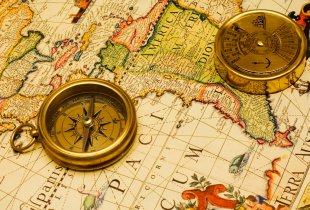Music in the Bahamas has a strong African and Caribbean
influence on it. But it’s also influenced by various folk music traditions and
the hip/hop scene from the US as well.
The most commonly associated musical genre associated with
the Bahamas is Junkanoo. It’s a street parade, in similar fashion to that of
Carnival or Mardi Gras. The people dress in wildly elaborate and colorful
costumes. Much of the music is similar to a marching band style, consisting
mostly of brass instruments (as a French horn/mellophone player, this makes it
the ideal marching band) and percussion. It’s thought that this type of
festival started during the 1700s and 1800s by slaves that were granted time
around Christmas to spend with their families. Junkanoo continued even after
they were granted their freedom, except now it has been expanded to contain
themes and prizes, etc.
With every junkanoo, the foundation of the music is based on
goombay drums (a drum with a goatskin head that’s held between the legs and
played with either hands or sticks; goombay, incidentally, also means rhythm in Bantu), cow bells, and mouth
whistles. Some tend to think that the brass section actually accompanies the rhythm section,
not the other way around as many people listen to music would perceive. (Some
percussionist probably thought that up.)
Rake-and-scrape is a type of music that is popular in the
Bahamas, especially on Cat Island where they hold a rake-and-scrape festival
every Labor Day. Related to the ripsaw music of nearby Turks and Caicos
islands, rake-and-scrape consists of using a saw is scraped by some object, a
knife blade being most common. The sounds produced mimic other percussion
instruments that are found more commonly in Latin or Indian music. It takes a little bit for them to get started, but just bear with it.
Folk music from freed African Americans that emigrated to
the Bahamas is also popular. One of the steadfast “fathers” of folk music is
Joseph Spence. He’s been called the Thelonious Monk of the folk guitar. His
polyphonic playing style and blend of gospel music, folk music, and even blues
reaches across all demographics. I love his music from the first that I heard
it. Definitely on my must-buy list. There are several albums and compilations
on iTunes, mostly for around $10.
And of course, probably the most famous group in recent
years is The Baha Men, giving us the song I love to hate: “Who Let the Dogs Out?” (only because it’s catchy, and in my daughter’s opinion of the music
video: “That. Was. Awesome!”). I
even, in my effort to be fair and listen to it from a musicologist’s point of
view, did in fact listen to most of the album, and, yes, there are other catchy
songs that feed my earworm as well. (There are things you do as a parent that you never thought you'd do before having kids. Singing about poop is one. Posting this song is another. This is for my kids.)
Two dances that are popular with rake-and-scrape music are
the Bahamian Quadrille and the Heel and Toe Polka. The quadrille and polka are
actually both European dances, and the Bahamians created their African version
of it. It's comprised of two lines, both males and females, where they come together, then separate. The key focal point of the quadrille is that the male dancer will stomp his
foot on the ground at the same time as a syncopated slap from the goombay. During
the junkanoo parades, you’ll often find more upbeat dancing, such as the
jump-in-dance.
There aren’t many videos on YouTube about these dances
specifically in the Bahamas, except junkanoo (the next time anyone in the Bahamas sees the other dances performed, please videotape it and put it on YouTube, for the sake of all humanity), although these dances are popular in variations
throughout the Caribbean.
Up next: the food!
Up next: the food!
Resources:
Wikipedia: “Ripsaw Music” “Junkanoo” “Joseph Spence”
Rake and Scrape: http://www.bahamasentertainers.com/Paper/rkeNscr.html
Bahamian Quadrille: The Garland Encyclopedia of World Music:
The United States and Canada.







